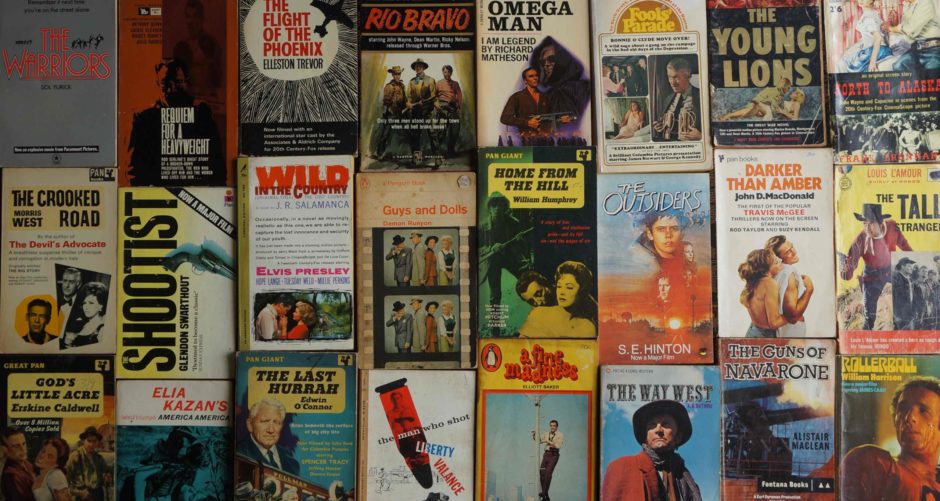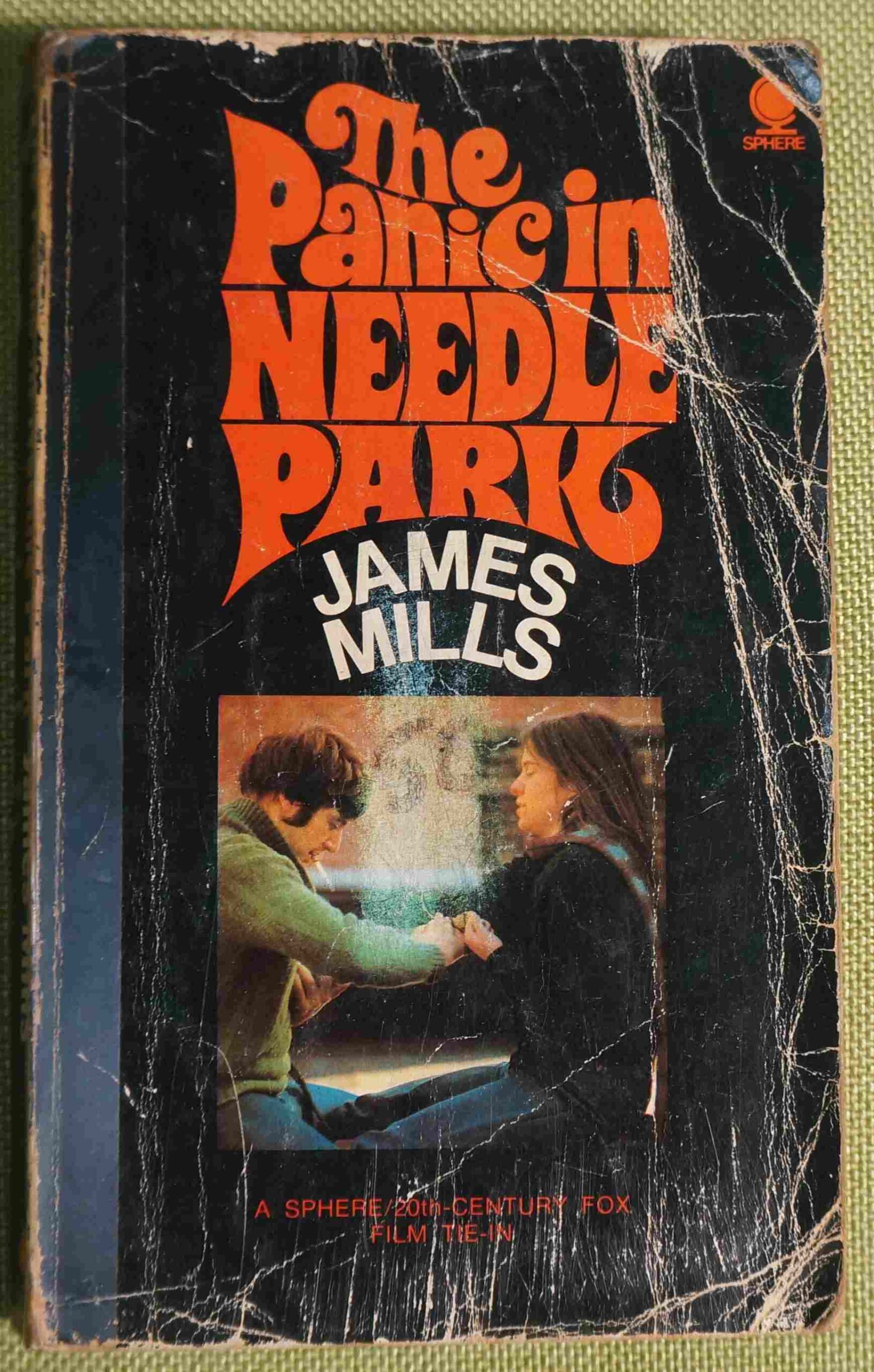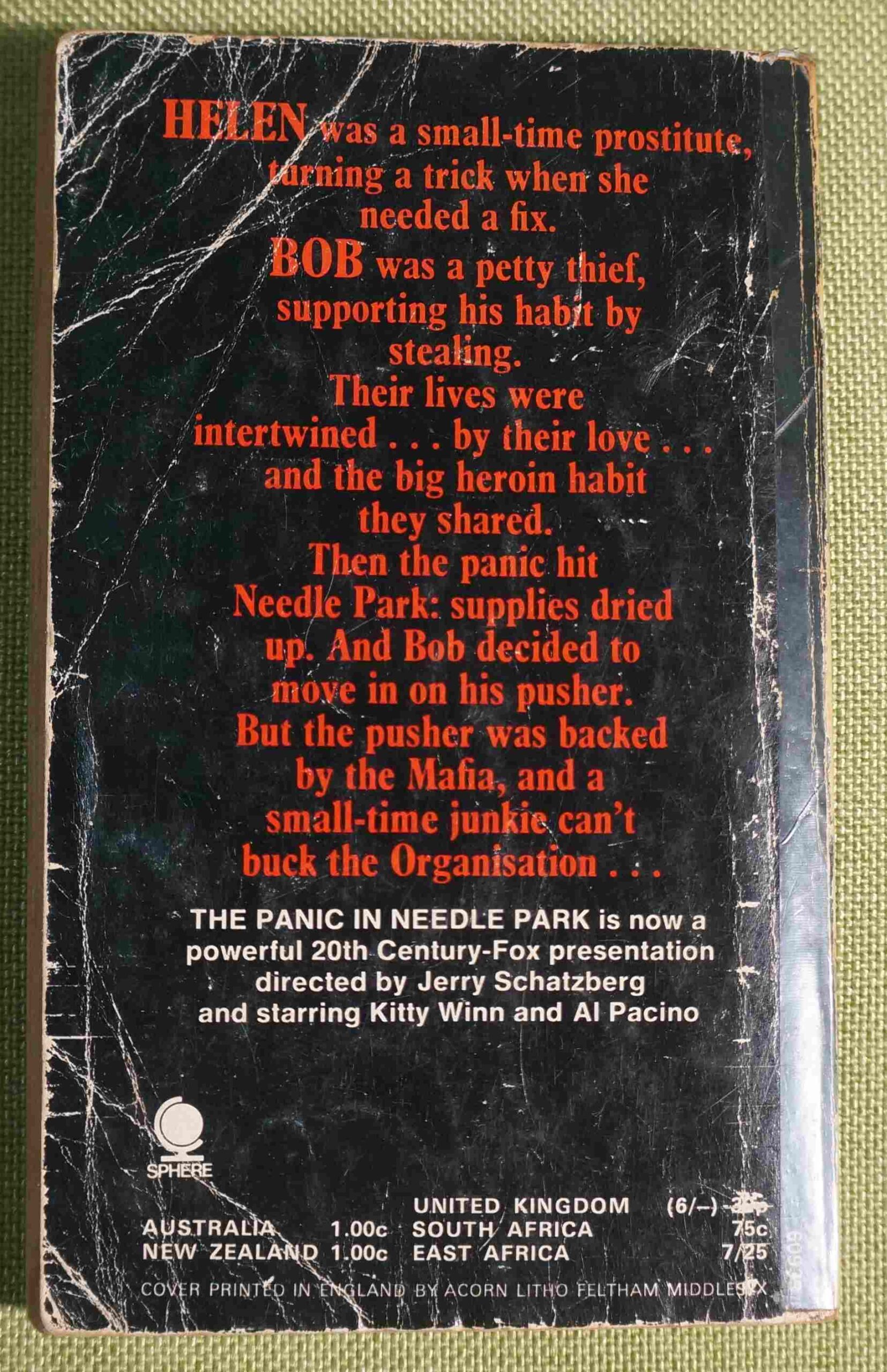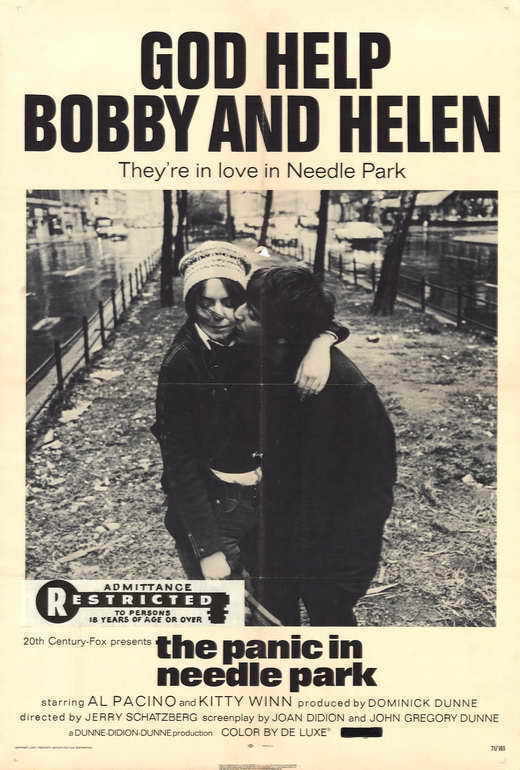FILM DIRECTOR: Jerry Schatzberg
SCREENWRITER: Joan Didion, John Gregory Dunne
FILM STARS: Al Pacino, Kitty Winn, Alan Vint, Richard Bright, Kiel Martin, Michael McClanathan, Warren Finnerty, Marcia Jean Kurtz, Raúl Juliá, Angie Ortega, Larry Marshall, Joe Santos, Paul Sorvino.
COUNTRY: USA
THIS BOOK
AUTHOR: James Mills
TYPE: Novel
PUBLISHER: Sphere
THIS EDITION PUBLISHED: 1971
COUNTRY: Great Britain
COVER: Paperback
THE ORIGINAL BOOK
ORIGINAL AUTHOR: As Above
YEAR FIRST PUBLISHED: 1966
ORIGINAL BOOK TITLE: The film title
NOTES
GENRE: Drama
WORDS: Its been a while since I saw this film and read the book (did I read it? … I think so, I recall so …).
I recall the film more and even that is a little hazy. As a late teen in the 80s I was watching a lot of “edgy” late 1960s and early 1970s films, and there were lots of them. It suited my youthful angry and committed attitude of the time. I was an avid “old” movie watcher and, though hiding in plain sight, these films were a revelation because for the first time in mainstream Hollywood, nothing was off limits.
(Hard) Drug addiction films in Hollywood weren’t new – The Man with the Golden Arm (1955), A Hatful of Rain (1957), Monkey on My Back (1957), The Connection (1961), Synanon (1965) all dealt with drug addiction. But those films as good as they are, and they are all good and some are excellent, still had to tip toe around the grim down and dirty “realities” of drug addiction. The 1970s films could look at the problem with a new realism, though, oddly, the 1970s had relatively few cautionary tales when it came to drugs. I assume people were enjoying their drugs too much to care.
What this film does do is weave a love story into the drug addiction so in a way it predates the more well knows Leaving Las Vegas (1995) and Drugstore Cowboy (1989).
The film put (the great) Al Pacino on the map. In his first lead role, Pacino plays the role of Bobby whose life is forever about the next score. He hangs out in “Needle Park” (a nickname at that time for Sherman Square on Manhattan’s Upper West Side near 72nd Street and Broadway – New York before it was cleaned up). He hooks up with Helen (Kitty Winn – her first film), a restless woman who finds him charismatic. She becomes an addict, and life goes downhill for them both as their addictions worsen, desperation and darkness become the norm, and all roads lead to a series of betrayals.
Author James Mills was a reporter for Life magazine and he drew upon his firsthand experience of New York City’s junkie underworld (in the mid 60s) to write this fictionalized account of a love affair between two junkies (he wrote an article about them before the book). Apparently, Mills spent months with a small-time street hustler and his girlfriend, a middle-class Midwesterner reduced to prostitution. Mills’ observations of their desperate struggle to score heroin during a shortage and their addiction is the whole story arc of the book, and it’s harrowing, without taking sides and without being preachy or moralistic. It is very “matter of fact”. It’s all about the nuts and bolts of drug addiction.
This is where the film departs from Mills’ novel … the film has the same characters, the drugs, and the setting, but concentrates more on the love story of Bobby and Helen.
And there is nothing wrong with that.
The film still refuses to preach or take sides but knows an audience needs to be invested in the characters and their lives, and knows it can’t just dwell on the drugs. The film shows the dangers of codependency crossed with addiction, and how a once positive relationship gradually decays into something unsustainable. It does this while avoiding all the usual stereotypes (though, perhaps, creating a few) by treating the story as a romantic drama with drugs. The love story here (and it’s not saccharine) gives you that. It is, perhaps, a hard drug version of (the wonderful) The Days of Wine and Roses (1962).
The story is basically a two part-er and both actors are great with Pacino especially good before he created the Pacino film persona. Fellow New Yorkers Raul Julia (first film) and Paul Sorvino (second film) and Joe Santos (seventh film) have small roles. Jewish New Yorker Jerry Schatzberg wasn’t prolific but always made thoughtful dramas which weren’t stagnant – Scarecrow (1973) (also with Pacino), The Seduction of Joe Tynan (1979), Honeysuckle Rose (1980), Misunderstood (1984), Street Smart (1987), Reunion (1989).
The film adaptation, written by Joan Didion and John Gregory Dunne, who were married to each other and collaborated on a number of screenplays including – A Star Is Born (1976), and True Confessions (1981). And they worked well together. Dunne was a journalist who knew history and politics and Didion a novelist and essayist who was particularly perceptive and poetic (her collection “Slouching Towards Bethlehem” (1968) is especially good).
Panic in Needle Park wouldn’t get much attention at the Academy Awards (though actress Winn won the Best Actress Award at the 1971 Cannes Film Festival and director, Jerry Schatzberg, was nominated for the Palme d’Or – the Oscars … always missing things), it’s too gritty for that and even now it is still quite confronting and realistic. I note here that Mills in his book treats (if I recall correctly) heroin addiction as more of a psychological dependency than a physical addiction. We know now it’s both.
Read the book, see the film.
I wonder what became of the young fictionalised real people Bobby and Helen – did they quite heroin, remain together, grow old?
TRIVIA
- Director Schatzberg photographed for magazines such as Vogue, Esquire and McCalls. As a still photographer he also took the cover photo of the Bob Dylan album Blonde on Blonde, released in 1966 (A collection of his images of Dylan titled Thin Wild Mercury was released in 2006)
- Author Mills also wrote Report to the Commissioner (1972) another journalist type novel about undercover cops and drugs in New York, which became a film of the same name in 1975.
LINKS
TRAILER
FILM POSTER




yep re Kirk … no one pushes Kirk around. His Bryna Production Company was involved with (partially funded) POG ..and…